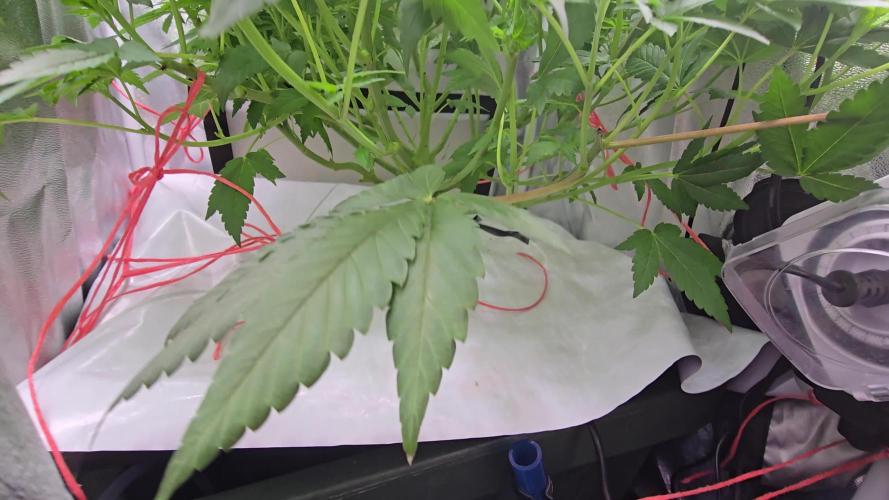The Grow Awards 2026 🏆 



























Likes
Comments
Share


@Compassionate_Gardener
Follow
During week 4 (=flowering week 2) the 18 CANNALOPE HAZE plants from DNA-GENETICS grew like hell and started to develop their first white hairs (=female pistils of the plant). The speed in which the little white crowns appear is astounding to me, I LOVE IT! The lamps are now hung at the producer recommended distance of 22 cm (=LUMATEK) and 45 cm (=SANlight) and both run at 100% power (=no more dimming for now!). The difference between the left side (=Lumatek) and right side (=SANlight) can be seen clearly in the videos. The plants on the right under the Q6W-Gen. 2 LED-Lamps from SANlight have a darker, healthier green color and have produced VISIBLY MORE FLOWERS then the plants on the left side under the Lumatek PRO 600W. Lets see how this goes further next week...😎
Likes
20
Share


@JohnnyBlaz3
Follow
Noyce, ok so we on track now but still not see that truly vigorous growth. I'm doing my best to move her under the deck when it rains to not dilute the nutes too much with rain water but i feel something is off a little. the leaves seem a little dark and a like hmmmmm a little to rigid or thick, not that nice lime green the whole way throuhgout you like to see with rapid growth. maybe the ph or mayb a slight nitrogen toxicity or possibly the combination of the two. So today i have her less of the growth nute and upped the cal meg slightly with a higher ph around 6.35 to see if i see some postive effects from this. I'm wondering if anyone has anytips on watering and such for outdoor girls in pots? still optimistic i'll get enough flower to achieve my main goal. to get high affffff watching pineapple express while smoking it. which im sure everyone does hahahha i can see the lady parts just coming out now where as the ones in the tent are about a week into flower
Likes
64
Share


@DogDoctorOfficial
Follow
Fast week and a lot in my life so little update for this week , sorry guys, they are growing as champions and by the end of week 5 they started preflowring, this append around day 34,35 from seed. I started a litle timelapse project an i will update on that soon , for now here just a taste of what it will be 😆💚
Girls 2# Magnum Autos from @buddhaseeds
All i grow is medicine for myself, nothing to sell
So don’t even ask 😆
💚If you put your heart in to it, you will get love out off it 💚
Growers love to you all
Likes
7
Share


@Kayotic
Follow
*Week 2 of flower
*Sprayed NPK Mighty and leaves are looking better
*Gave Tiger Bloom and Dr. Earth Flower Girl.
*Watering every day, sometimes twice
*Smells like the Zkittles I remember
Likes
Comments
Share


@Robom069
Follow
Day 75/76
everything is going to grow together so the compounds the way they should and i dont get bugs or overstimulated effects
so it should be a pretty good harvest in 2 months
Processing
Likes
18
Share


@Barcelona_Farmers710
Follow
Esta la pasaremos junto las 2 Runtz x Strawnana y la tiger bomb al armário grande, cuando acabemos el seguimientos de Royal Queen Seeds! Entrenaremos el Scrog por primera vez.🤙🏻
Likes
82
Share


@UnorthadoxDude
Follow
Hello growmies! Welcome to week six of An Epsilon Adventure! Massive thanks to both Shogun and Royal Queen Seeds for sponsoring this grow!
So here we are at week six and every one of these girls are at a slightly different stage, it is quite fascinating to watch them develop one after the other.
Today I made the last adjustment to the light possible. I removed the adjustable hangers and affixed a carabiner which I tightly tied to the top of the tent bar. There is about 1.5 inches of space between the top of the shade and the tallest part of the roof of the tent. Plant 1 is already taller than this, and it looks like plant 6 and maybe even plant 5 are going to join it. It's a madness. I am sure you have already looked at the photos but just in case you do what I do and read the diary first...
Here is my assessment at the beginning of week 6:
Plant 1:
Height: 1st (137cm) - what can I say about this ridiculous plant? Day 36... 137cm tall. I have had to raise the light to as high as it is physically possibly to raise it and it's still not high enough. She is done stretching now, she may add 3-5cm over the next week or so but I don't expect more than that, so her top of her main cola going to have to develop above the level of the light. Nothing I can really do, nothing wise anyway. What a monster plant.
Maturation: 4th - early into flower - bud sites developing, pistils just starting to explode.
Plant 2:
Height: 4th (111cm) - this plant has been there or there abouts as the tallest plant for most of the grow, but she has topped out at 111cm. She will gain some during flower but not much more than a few centimetres. Very impressive plant, loads of bud sites, really big strong secondary branches. This one is going to be colas galore.
Maturation: 3rd - well into flower - all white pistils
Plant 3:
Height: 6th (95cm) For some brief days the tallest plant in the room, she peaked early and is now the "shortest" at "only" 95cm for this "50-70cm" strain. She is utterly dwarfed by four of her five sisters in just about every department, being quite a bit smaller even than plant 4 (although I have removed the most lower nodes from this plant). Compared with her sisters she is almost a runt... except that she is 25cm taller than the strain top-end average and matches the maximal height of the previous tallest Epsilon F1 plant I am aware of. It's not that she is small, actually she's pretty big for an Epsilon F1, it's just that the rest of the girls are on another level altogether. Plants 1, 5 and 6 are all absolute beasts.
Maturation: 1st - well into flower - first shades of brown in some pistils.
Plant 4:
Height: 5th (98cm) although only 3cm taller than plant 3, overall she is a much larger plant. Her secondary nodes are the same height as plant 3.
Maturation: 2nd - well into flower - all white pistils
Plant 5:
Height: 3rd (113cm) - one of the two thick/short girls who have grown at a similar pace all along - she is further ahead than plant 6 but not by much and I think she will probably exceed 120cm this week, though I do not think she will outgrow plant 1 or 6.
Maturation: 5th - early into flower - bud sites developing.
Plant 6:
Height: 2nd (120cm) - my predictions were correct about this girl and her continued growth. I now think she might actually outgrow plant 1, which is quite worrying.
Maturation: 6th - early into flower - bud sites forming - by far the least mature plant of the six.
###
Week 6 Day 2 23:00 30/7
Photographed. Raised the light. Rotated the plants. Inspected, measured and reported on each plant.
###
Week 6 Day 3 23:00 31/7
It has not escaped my attention that the plants that are more advanced into flower have darkened and have some burnt tips. I need to flush them and lay off the base nutes a bit. These plants are just growing and maturing so quickly that I cannot keep up.
###
Week 6 Day 5 02:30 2/8
Fertigated 3l of nutrient mix, without either COCO A or B.
###
Week 6 Day 6 01:30 3/8
photographed
---
Thanks for reading growmies! 👊
==========
Tent: 120cm x 120cm x 180cm
Light: 600w HID Elite Dual Spectrum HPS + Angel Wing Reflector
Air: 5" duct fan system with carbon filter ~300 m3/hour + RAM 9" floor fan + 4" intake fan
Pots: Air Pruner Fabric Pots 30l - UGro XL Coco + horticultural grade perlite (~20%)
Seeds supplied by Royal Queen Seeds https://www.royalqueenseeds.com
Nutrients supplied by Shogun Fertilisers https://www.shogunfertilisers.com/en
==========
Likes
67
Share


@AwfulBuddy
Follow
We are almost there!
Second ripening week and after this i will get with AN final flash.
I'm giving half the power to the lights for an hour in the morning and one in the evening, a kind of sunrise and sunset, removed the heater from the tank so as to simulate the arrival of the autumn cold, the tops have a purple color.
everything seems to flow
thanks for your visit here buddies
wish you the best 💚🌱🤜🏼🤛🏼
Finally i've taked some smartphone camera pics only smartphone flashlight and grow lights off.
I feel it will be around 300g harvested, what do you think about it? 🤔🤓
Likes
11
Share


@RFarm21
Follow
Week 26 August - 1 september
26 August - just water (1.5l)
29 August - feed day
1 september - feed day
Likes
2
Share


@DankieDoodle
Follow
DankieDoodle 📅 Vegetative – Week 3, Days 1–7
✂️ Topping & Transition Week
This week marked an important step in shaping the structure all three girls, Pure Runtz (T.H.Seeds), Strawberry Poprocks (Anesia Seeds), and Radical Juice (Ripper Seeds), were topped cleanly above the 4th node to begin forming their SCROG-ready main frame.
All cuts healed fast, and the plants responded perfectly zero stress, vibrant color, and compact, even growth.
💧 Watering & Feeding
Day 1: Each plant received 1 L of water, following the regular schedule.
Absorption was perfect no runoff, great structure, and a healthy, active root zone.
Water Mix:
RootJuice — 1 ml/L
Biobizz Heaven — 2 ml/L
Epsom Salt — 0.15 g/L
pH — natural (7.4 tap water)
💡 Environment:
Temp: 25 °C
RH: 68–70 %
PPFD: ~550 µmol/m²/s (Mars Hydro FC4000 EVO @ 50 %)
Cycle: 18/6
VPD: ~1.0 kPa
🌿 Midweek (Day 4)
All three plants were watered again with 1 L each, using the same nutrient mix.
Substrate dried evenly, roots are expanding rapidly, and all three show symmetrical, low-stress growth.
🌞 End of Week (Day 7)
By Day 7, the pots were drying out completely after only two days a clear sign of a well-developed root system.
The Autopots were activated today to let the plants get used to consistent moisture levels before the next growth stage.
🚀 Radical Juice (Ripper Seeds) Note:
Between Day 5 and Day 7, she showed explosive vertical growth, pushing herself right into 650 µmol/m²/s PPFD resulting in slight tip burn on the top leaves.
Nothing serious, just a light stress mark from her incredible vigor.
The light intensity has since been adjusted down to 550 µmol/m²/s for all plants to maintain perfect balance and canopy health.
🌱 Summary:
Structure after topping looks perfect four strong mains on each.
All three cultivars are balanced, compact, and healthy.
Radical Juice shows top-tier growth potential; all plants are ready for the next phase.
A clean and productive week steady growth, solid recovery, and the Autopots now active to keep the rhythm flowing.
Next step: another topping and the first round of gentle LST to open up the canopy evenly 🌿✨
Likes
19
Share


@adam_pawloski87
Follow
What another great week it’s been , today is Day 39 from seed an the lil ladies have jumped into preflower 😍! Yesterday gave em the trim up of the unders , kinda popsicled you can say to each one, cause we want to focus on them colas ! This week we should see some more great progress, let them caps start stacking ! Can’t wait to see what we do next week ! Hope you all enjoy an have an amazing productive day! Peace love an positive vibes to y’all Cheers 😶🌫️💨💨💨💨💨🤙🏻
Likes
2
Share


@Sobreruedas
Follow
En esta semana he visto que tengo trips y le he hecho 2 riegos foliar uno con insecticida y el otro con Jabón Potásico y Aceite de Neem
Likes
5
Share


@TerpTime
Follow
Willkommen zur achten Woche – Blütewoche 4 liegt hinter uns
Wouw – acht Wochen sind schon wieder vorbei! Leider kommt das Update diesmal etwas verspätet, da mich eine Krankheit kurzfristig ausgebremst hat. Die Woche selbst verlief allerdings sehr ruhig. Die tägliche Arbeit ist inzwischen auf ein absolutes Minimum gesunken, da die Ladys ihre Routine gefunden haben und konstant weiterarbeiten. Die Entwicklung bleibt – wie in den Wochen zuvor – durchweg hervorragend. Fast die gesamte Blütezeit liegt bisher im absoluten Sweetspot, was sich nicht nur sehen, sondern trotz Filter und konstantem Unterdruck auch deutlich riechen lässt.
Das Terpenprofil ist bereits jetzt sehr ausgeprägt. Es verteilt einen intensiven, süßen Duft im Raum, der stark an Zitrone, Limone und andere fruchtige Aromen erinnert. Besonders spannend ist dabei, dass sich die Aromen trotz der Geruchsfilterung gut durchsetzen – ein deutlicher Hinweis auf ein kräftiges Terpenprofil und gesunde Pflanzen.
In puncto Wachstum hat vor allem die kleine Nachzüglerin in dieser Woche ordentlich aufgeholt. Mit über 37 cm Zuwachs steht sie nun bei beachtlichen 98 cm. Die Pflanze unten rechts hat sich auf 105 cm gestreckt, oben rechts misst nun 83 cm. Und der dominante Sativa-Phänotyp hat es mittlerweile sogar auf stolze 130 cm geschafft. Da sich das Höhenwachstum bei den meisten weitgehend abgeschlossen hat, geht nun sichtbar mehr Energie in die Ausbildung der Blütenstände – und das merkt man. Die Buds haben in der letzten Woche ordentlich an Volumen und Harz zugelegt und wirken schon jetzt vielversprechend.
Nährstofftechnisch habe ich Green Sensation inzwischen durch Canna PK 13/14 ersetzt. Zusätzlich kam Cannazym zum Einsatz, um die große Wurzelmasse gesund zu halten und den Stoffwechsel zu unterstützen. Leaf-Tucking wird weiterhin regelmäßig angewendet, um den unteren Trieben Licht zu verschaffen, ohne die Pflanzen unnötig zu belasten. Zudem wurden die Ladys in dieser Woche ein letztes Mal entlaubt, um die Luftzirkulation zu verbessern und den Fokus voll auf die Blütenbildung zu lenken.
Besonders zufrieden bin ich aktuell mit der Klimasteuerung – VPD, Luftfeuchtigkeit und Temperatur sind sehr stabil und genau im gewünschten Bereich. Das schafft optimale Bedingungen für die Photosynthese und fördert die Harzbildung in dieser entscheidenden Phase.
Insgesamt bleibt es spannend. Der Platz im Zelt ist inzwischen sichtlich zu knapp, was die Luftzirkulation und Lichtverteilung etwas erschwert. Trotzdem bin ich sehr zufrieden mit dem bisherigen Verlauf und freue mich auf die kommenden Wochen – denn jetzt geht es langsam auf die Zielgerade zu.
Likes
3
Share


@Skunkiest_bender39
Follow
Umzug in Gewächshaus ist vollbracht. Die eine Dame ist viel zu groß geworden also bleibt sie solange draußen wie es nur geht! Die Damen im Gewächshaus haben ideale Bedingungen. Tagsüber bis 30* und um 30% LF. Nachts Heizung und Lüfter sorgen für 15* und ca 55% LF
































